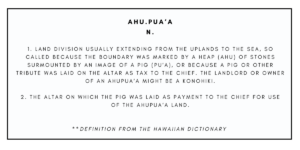An ahupuaʻa is an ancient Hawaiian land division system that played a vital role in the organization of land and resource management in the Hawaiian Islands.
We will begin this post by sharing the definition of ahupuaʻa from the Hawaiian dictionary:

Next, to better understand how the system worked, let’s look at some key characteristics of an ahupuaʻa:
Land Division: Each ahupuaʻa was a strip of land that extended from the mountains down to the sea, effectively dividing the island into manageable sections. This design allowed Hawaiians to access a wide range of ecosystems, from the upland forests to the coastal areas, which in turn provided them with diverse resources.
Resource Management: The ahupuaʻa system was built on the principle of resource sustainability. Hawaiians practiced various forms of agriculture, including the cultivation of taro (kalo), sweet potatoes (ʻuala), and other crops in the uplands, and the maintenance of fishponds and fish weirs in coastal areas. This ensured a steady supply of food and resources for the local communities.
Social Structure: Each ahupuaʻa was ruled by a chief or aliʻi who was responsible for overseeing the management of the land and its resources. The people living within the ahupuaʻa contributed to the chief’s needs, often through labor and resources, while receiving protection and access to the land’s resources in return.
Cultural Significance: Deep cultural and spiritual significance in Hawaiian society is held in the Ahupuaʻa land division system. Many contained heiau (temples) and were connected to traditional Hawaiian beliefs and practices, reinforcing the spiritual connection between the land and its people.
The ahupuaʻa system ensured the self-sufficiency of Hawaiian communities by creating a balanced and sustainable ecosystem within each division of land. It was a holistic approach to land management, where the careful allocation of resources allowed communities to thrive for centuries.
The arrival of Western explorers and settlers had a profound impact on the Hawaiian Islands and their traditional systems. The Hawaiian monarchy was overthrown in 1893, and the ahupuaʻa system began to erode as Western land ownership models were imposed.
However, in recent decades, there has been a resurgence of interest in and commitment to the principles of ahupuaʻa. Local communities, conservation organizations, and government agencies have been working together to revive traditional land management practices and protect Hawaii’s unique environment. This has included efforts to restore fishponds, revitalize taro farming, and protect watershed areas.
The ahupuaʻa system left a legacy in Hawaii, and its principles remain relevant today. The focus on sustainable land management, community engagement, and cultural preservation has inspired modern Hawaiians to reconnect with their heritage and find innovative ways to address contemporary challenges. For anyone residing or visiting Hawaiʻi, learning about Hawaiian cultural practices and being an ally and advocate to help these practices remain relevant is incredibly important.
This renaissance has not only had a positive impact on the environment but also on local economies and communities. By embracing the spirit of ahupuaʻa, Hawaiians are working towards a future that balances modern needs with the wisdom of their ancestors.
The ahupuaʻa system represents a remarkable example of how ancient cultures developed sustainable ways of life deeply connected to their environment and this significance has not been forgotten. The revival of ahupuaʻa principles in modern Hawaiʻi is a testament to the enduring significance of these ancient traditions, ensuring that they will continue to shape the islands and their people for generations to come.
If you’d like to find out which ahupuaʻa you reside in, visit this State of Hawaiʻi map.